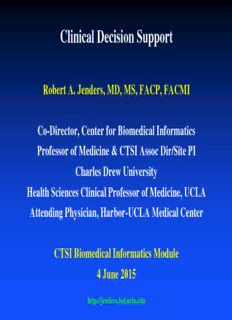
Clinical Decision Support PDF
Preview Clinical Decision Support
Clinical Decision Support Robert A. Jenders, MD, MS, FACP, FACMI Co-Director, Center for Biomedical Informatics Professor of Medicine & CTSI Assoc Dir/Site PI Charles Drew University Health Sciences Clinical Professor of Medicine, UCLA Attending Physician, Harbor-UCLA Medical Center CTSI Biomedical Informatics Module 4 June 2015 http://jenders.bol.ucla.edu Learning Objectives • Understand key drivers of CDS, including availability of structured data for personalized medicine • Learn the definition and scope of CDS – CDS = Applying knowledge to data • Describe the details of standards and how they are used to implement CDS Theme: Using Standards to Improve Knowledge Sharing in CDS • CDS technology exists but is not being used optimally – Need to improve knowledge sharing (transfer, reuse, service-mediated access): Reduce the cost, improve the reliability of knowledge engineering, increase the likelihood of CDS use • Approach: Standards – Standards: Not enough; too many! • Fill in current gaps + convergence – Make it easier • Better knowledge transfer • Better knowledge access: Standard interfaces instead of standard KR • Provide guidance on how to use CDS Driver of CDS: Meeting Information Needs • Systematic review: N = 72 studies of needs of physicians, medical residents, physician assistants, nurse practitioners, nurses, dentists and care managers • Frequency of clinician questions (mean) – 0.57 questions/patient seen – Clinicians pursued 51% – Clinician need met in 78% of these • Domain of questions – Drug tx: 34% – Cause of symptom, finding, test result: 24% Del Fiol G, Workman TE, Gorman PN. Clinical questions raised by clinicians at the point of care: a systematic review. JAMA Intern Med. 2014 May 1;174(5):710-8. Need/Challenge for CDS: Changing Behavior • USA: Only 54.9% of adults receive recommended care for typical conditions – community-acquired pneumonia: 39% – asthma: 53.5% – hypertension: 64.9% McGlynn EA, Asch SM, Adams J et al. The quality of health care delivered to adults in the United States. N Engl J Med 2003;348:2635-2645. • Delay in adoption: 10+ years for adoption of thrombolytic therapy Antman EM, Lau J, Kupelnick B et al. A comparison of results of meta-analyses of randomized control trials and recommendations of clinical experts. Treatments for myocardial infarction. JAMA 1992;268(2):240-8. Challenge for CDS: Explosion in Data + Knowledge Stead WW, Searle JR, Fessler HE et al. Biomedical informatics: changing what physicians need to know and how they learn. Acad Med 2011Apr;86(4):429-434. A Rationale for Standardization: CDS Osheroff JA, Teich JM, Middleton B et al. A roadmap for national action on clinical decision support. J Am Med Inform Assoc. 2007 Mar-Apr;14(2):141-5. CDS National Roadmap: Three Pillars • Enhanced health and health care through CDS – Best knowledge available when needed – High adoption & effective use – Continuous improvement of knowledge & CDS methods Jenders RA, Morgan M, Barnett GO. Use of open standards to implement health maintenance guidelines in a clinical workstation. Comput Biol Med 1994;24:385-390. Rationale: “Meaningful Use” • Monetary incentive program created by ARRA HITECH (2009): Payments by CMS for participation • Key ingredients: Use CEHRT “meaningfully” (eRx), health data exchange, reporting quality measures • Phases – Stage I (2011-2012): Hospitals report 20/24 quality measures – Stage II (2013): Electronic data exchange (structured lab data, immunization registries), listing patients by condition, etc – Stage III (2017+): 2015 NPRM just closed for public comment (29 May) http://www.cms.gov/Regulations-and- Guidance/Legislation/EHRIncentivePrograms/index.html CDS: Definitions • Foundational: Key origin of field of Biomedical Informatics – AIM == Artificial Intelligence in Medicine – Computer-based diagnosis in the heyday of AI • Now: Intelligent assistant – Support / assist human decision-makers, not supplant them • Core: Applying knowledge to data Miller RA. Medical diagnostic decision support systems—past, present and future: a threaded bibliography and brief commentary. J Am Med Inform Assoc 1994;1:8-27.
Description: